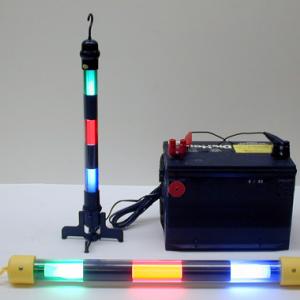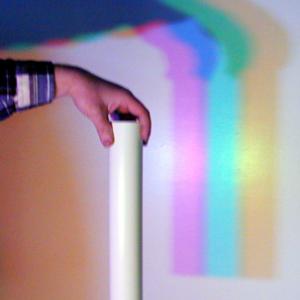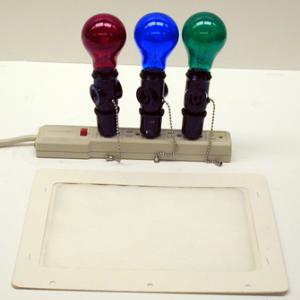College of Liberal Arts & Sciences
6F10.45 - Complementary Shadows
Turn on either one of the light wands and point towards a white screen or background. The color will appear white until some object is placed between the light and the screen. At that point secondary colored shadows will be produced (Cyan, Magenta, and Yellow).
Look at brightly colored pictures, stickers, or posters under the different colored lights. See how differently the "normal" colors look when illuminated with the red, blue, or green lights.
- Gorazd Planinsic, "Color Mixer for Every Student", TPT, Vol. 42, #3, Mar. 2004, p. 138.
- Cruse Melvin and Timothy Melvin, "Mixing Colors in the Hall", TPT, Vol. 33, #5, May 1995, p. 292.
- Martin Gardner, "Colored Shadows", TPT, Vol. 31, #9, Dec. 1993, p. 554.
- "Figuring Physics", TPT, Vol. 28, #6, Sept. 1990, p. 430.
- Robert Gardner, "Colored Light and Shadows", TPT, Vol. 16, #7, Oct. 1978, p. 477, also A Potpourri of Physics Teaching Ideas - Optics and Waves, p. 176.
- O-750: "Flashlights & Colored Shadow", DICK and RAE Physics Demo Notebook.
- Pat Murphy, Ellen Macaulay, and the staff of the Exploratorium, "Colored Shadows", Exploratopia, p. 315.
- Martin Gardner, "Colored Shadows", Science Tricks, p. 63.
- Martin Gardner, "Color Complements", Entertaining Science Experiments with Everyday Objects, p. 79.
- "Experiment with Colored Electric Lamps", The Boy Scientist, p. 100.
- Jearl Walker, "7.40, Colors of Shadows", The Flying Circus of Physics Ed. 2, p. 320.
- Kelvin Trefz, "Simple AC Demonstrator", PIRA Newsletter, Vol. 13, #17, Jan. 1990.
- Raymond Bruman, "Colored Shadows", Exploratorium Cookbook I, p. 28.1 - 28.2.
- Bobby Mercer, "Crazy Shadows", Junk Drawer Physics, p. 104.
- C. Harvey Palmer, "Experiment A19: Demonstration of Color By Contrast", Optics - Experiments and Demonstrations, John Hopkins Press, 1962.
Disclaimer: These demonstrations are provided only for illustrative use by persons affiliated with The University of Iowa and only under the direction of a trained instructor or physicist. The University of Iowa is not responsible for demonstrations performed by those using their own equipment or who choose to use this reference material for their own purpose. The demonstrations included here are within the public domain and can be found in materials contained in libraries, bookstores, and through electronic sources. Performing all or any portion of any of these demonstrations, with or without revisions not depicted here entails inherent risks. These risks include, without limitation, bodily injury (and possibly death), including risks to health that may be temporary or permanent and that may exacerbate a pre-existing medical condition; and property loss or damage. Anyone performing any part of these demonstrations, even with revisions, knowingly and voluntarily assumes all risks associated with them.


